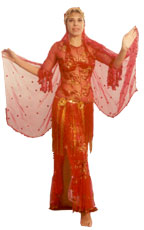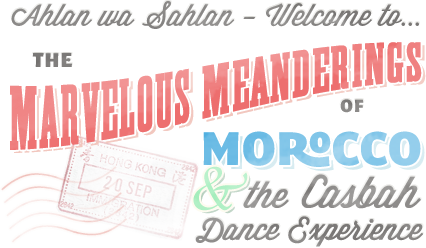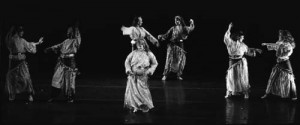With its origins nearly 5,000 years ago in rituals which celebrated a variety of gods, Middle Eastern dance comes from the people. Taught and practiced in socially and sexually segregated cultures which span from North Africa, through present day Islam to India, the classical and folk dances of this expansive region currently are being transformed by an influx of Western music and indigenous fundamentalist sects.
Under the yoke of colonial rule by the British and French, Middle Eastern dance faced misinterpretation and Victorian mores which stereotyped various dance forms as erotic. With the formation of her Casbah Dance Experience in l978, the Rumanian-born dancer Morocco sought to redress misconceptions about generic dances of North Africa, Central Asia, Yugoslavia, the Caucasus and the Middle East.
Through research, trips to the region where she witnessed ceremonial birthing dances in the mountains of Morocco, and instruction, Morocco instills her dancers with her aim to preserve traditional dance while educating an American public socially and politically remote from the region.

Whether swaying in half-turns like the veiled Berber women of the Guedra or gently lowering the back into a tucked position as in the lotus dance which expresses the mythologies of Egypt, India and China, the Casbah group reveled in the spiritual world.
Undulating hips and intricate foot patterns exhibited some of the Spanish influence in Middle Eastern dance. Great dexterity and balance adorned the Moroccan tea tray dance.
Garments are often used to accentuate movement as in the circular and line dances originally performed during pre-wedding ceremonies.
Various dances concentrate rhythmical patterns in isolation with upper torso, lower torso and arms and hands exchanging emphasis. What remains most striking throughout is the symmetry and controlled space of the movement.
With the exception of East West Fusion, performed by guest artist, Beth Anne Ferguson, the program devoted itself to traditional classical folk dances from Northern Africa and the Middle East with special attention to Egypt and Morocco. East West Fusion lacked the grace of the traditional forms from which it evolved, but showed some potential in blending contemporary African-American pop rhythms and rap with a narrative theme to the more ritualistic forms of the ancient Middle East.

